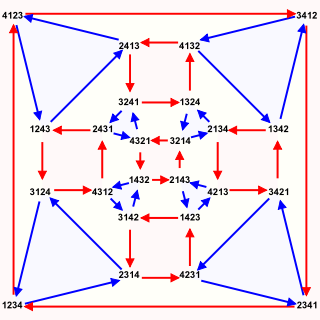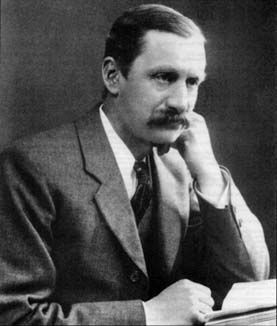Related Research Articles

In mathematics, specifically group theory, given a prime number p, a p-group is a group in which the order of every element is a power of p. That is, for each element g of a p-group G, there exists a nonnegative integer n such that the product of pn copies of g, and not fewer, is equal to the identity element. The orders of different elements may be different powers of p.

In abstract algebra, the symmetric group defined over any set is the group whose elements are all the bijections from the set to itself, and whose group operation is the composition of functions. In particular, the finite symmetric group defined over a finite set of symbols consists of the permutations that can be performed on the symbols. Since there are such permutation operations, the order of the symmetric group is .

In mathematics, a simple group is a nontrivial group whose only normal subgroups are the trivial group and the group itself. A group that is not simple can be broken into two smaller groups, namely a nontrivial normal subgroup and the corresponding quotient group. This process can be repeated, and for finite groups one eventually arrives at uniquely determined simple groups, by the Jordan–Hölder theorem.

In mathematics, more specifically in the field of group theory, a solvable group or soluble group is a group that can be constructed from abelian groups using extensions. Equivalently, a solvable group is a group whose derived series terminates in the trivial subgroup.

In mathematics, specifically group theory, a nilpotent groupG is a group that has an upper central series that terminates with G. Equivalently, it has a central series of finite length or its lower central series terminates with {1}.

A group is a set together with an associative operation that admits an identity element and such that there exists an inverse for every element.

In mathematics, a linear algebraic group is a subgroup of the group of invertible matrices that is defined by polynomial equations. An example is the orthogonal group, defined by the relation where is the transpose of .

In mathematics, particularly in group theory, the Frattini subgroup of a group G is the intersection of all maximal subgroups of G. For the case that G has no maximal subgroups, for example the trivial group {e} or a Prüfer group, it is defined by . It is analogous to the Jacobson radical in the theory of rings, and intuitively can be thought of as the subgroup of "small elements". It is named after Giovanni Frattini, who defined the concept in a paper published in 1885.

In mathematics, a reductive group is a type of linear algebraic group over a field. One definition is that a connected linear algebraic group G over a perfect field is reductive if it has a representation that has a finite kernel and is a direct sum of irreducible representations. Reductive groups include some of the most important groups in mathematics, such as the general linear group GL(n) of invertible matrices, the special orthogonal group SO(n), and the symplectic group Sp(2n). Simple algebraic groups and (more generally) semisimple algebraic groups are reductive.
In mathematics, especially in the area of algebra known as group theory, the Fitting subgroupF of a finite group G, named after Hans Fitting, is the unique largest normal nilpotent subgroup of G. Intuitively, it represents the smallest subgroup which "controls" the structure of G when G is solvable. When G is not solvable, a similar role is played by the generalized Fitting subgroupF*, which is generated by the Fitting subgroup and the components of G.
In mathematics, specifically group theory, a subgroup series of a group is a chain of subgroups:

In mathematics, Burnside's theorem in group theory states that if G is a finite group of order where p and q are prime numbers, and a and b are non-negative integers, then G is solvable. Hence each non-Abelian finite simple group has order divisible by at least three distinct primes.
In mathematics, the term socle has several related meanings.
In mathematics, in the realm of group theory, the term complemented group is used in two distinct, but similar ways.
In abstract algebra, a chief series is a maximal normal series for a group.
In group theory, a branch of mathematics, a normal p-complement of a finite group for a prime p is a normal subgroup of order coprime to p and index a power of p. In other words the group is a semidirect product of the normal p-complement and any Sylow p-subgroup. A group is called p-nilpotent if it has a normal p-complement.
In mathematical finite group theory, an N-group is a group all of whose local subgroups are solvable groups. The non-solvable ones were classified by Thompson during his work on finding all the minimal finite simple groups.
In mathematics, the O'Nan–Scott theorem is one of the most influential theorems of permutation group theory; the classification of finite simple groups is what makes it so useful. Originally the theorem was about maximal subgroups of the symmetric group. It appeared as an appendix to a paper by Leonard Scott written for The Santa Cruz Conference on Finite Groups in 1979, with a footnote that Michael O'Nan had independently proved the same result. Michael Aschbacher and Scott later gave a corrected version of the statement of the theorem.
In mathematics, semi-simplicity is a widespread concept in disciplines such as linear algebra, abstract algebra, representation theory, category theory, and algebraic geometry. A semi-simple object is one that can be decomposed into a sum of simple objects, and simple objects are those that do not contain non-trivial proper sub-objects. The precise definitions of these words depends on the context.
In the mathematical subject of geometric group theory, an acylindrically hyperbolic group is a group admitting a non-elementary 'acylindrical' isometric action on some geodesic hyperbolic metric space. This notion generalizes the notions of a hyperbolic group and of a relatively hyperbolic group and includes a significantly wider class of examples, such as mapping class groups and Out(Fn).
References
- Robinson, Derek John Scott (1996), A course in the theory of groups, Berlin, New York: Springer-Verlag, ISBN 978-0-387-94461-6